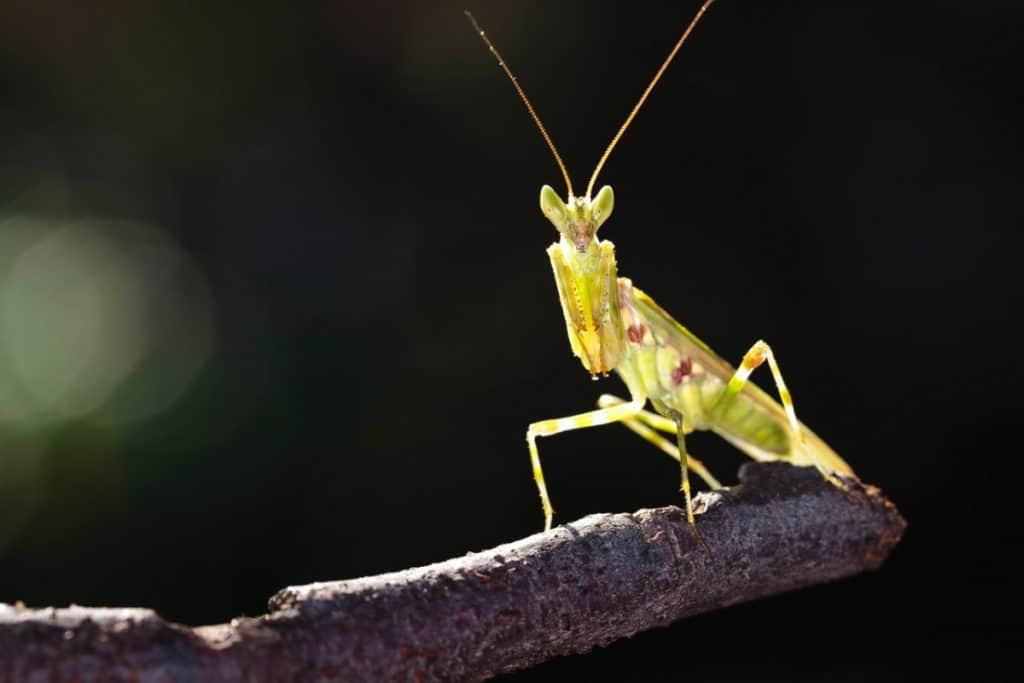
If you enjoy reading this article, why not check out our articles on What Do Praying Mantis’ Eat? A Complete Guide and How Fast Do Roaches Spread? Short Answer FAST!
What are the largest species of mantis?
Living Large With the Mantis
Mantises have over 2,300 species and are part of the, “Mantodea,” order of insects. They are fascinating insects that are predatory and therefore very helpful in eating other insects that would otherwise be a nuisance to your household. On average a mantis in captivity will live for about a year, with this average being a good deal lower in the wild due to one unique element of the mantis that significantly cuts the lifespan of males short.
Namely, after mating the female will sometimes eat the male (this provides nutrients to help the female with potentially laying more eggs. This is known as sexual cannibalism and really cuts the lifespan of a male Mantis shorter as sex 1-in-4 times equals death for a male Mantis. Now, assuming nobody gets eaten a year is pretty accurate, but it can vary some depending on the Mantis species and the assorted kinds of Mantis all have interesting and unique quirks worth discussing, so an assortment of species will now be examined.
The Praying Mantis
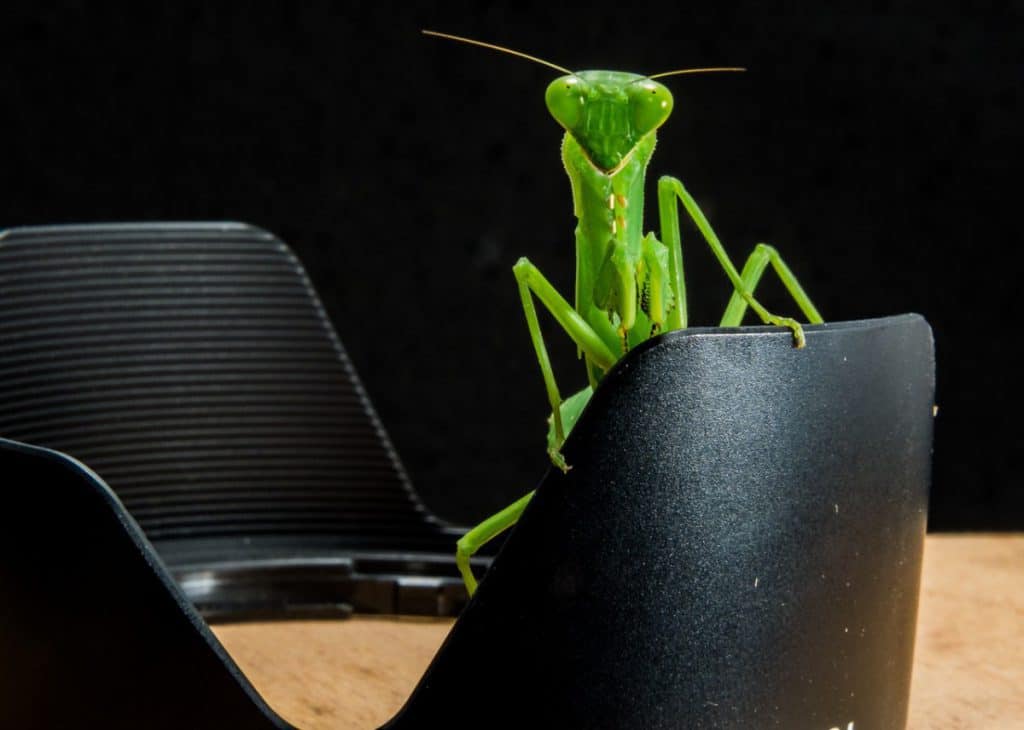
Average Lifespan: 1 year in captivity, much less in the wild,
Interesting Quirk: They look as if they are praying.
Details: Arguably the most, “Famous,” all the Mantis species, the Praying Mantis earns its name from how when it is resting its two front legs look folded-over as if in prayer.
The Praying Mantis species is like all other Mantis species in that the female is always a good deal larger than the male. Pray Mantises are generally a bright green to dark brown color. Interestingly males can and will often fly but females rarely will fly due to their larger size–they do have wings they can flutter to scare away something that might consider eating them like a bird or mouse, however! Praying Mantises are one of the more common species kept as pets and can live for around a year in captivity (assuming there is no mating and sexual cannibalism). When in captivity they do not need a water dish as they will drink water droplets off leaves as long as you, “Mist,” their aquarium/terrarium/home enclosure daily. They like to eat live insects and the largest-sized Praying Mantises have even been observed eating small frogs or lizards.
The Carolina Mantis
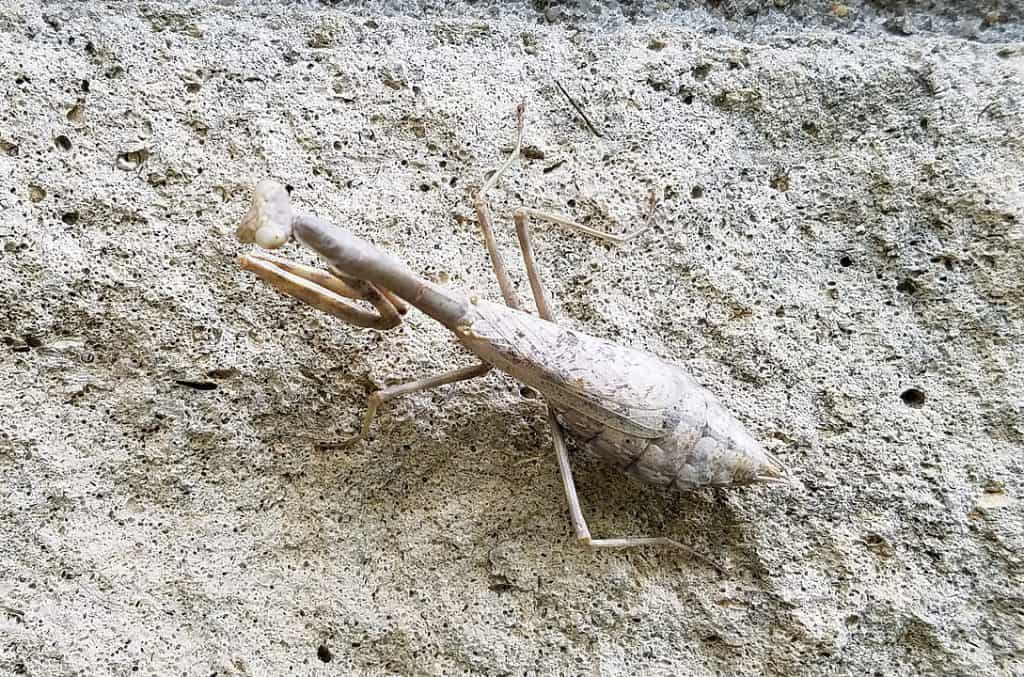
Average Lifespan: 1 year in captivity, much less in the wild,
Interesting Quirk: The name is misleading, this Mantis is actually the most common across all of North America, not just the Carolinas!
Details: The Carolina Mantis is (as noted above) the most common Mantis found in North America. They have the classic, “Mantis-look,” with their beady eyes and thicker bag legs and smaller forelegs.
The Carolina Mantis has a bit of a pointed mouth that actually almost looks like a beak. As with other Mantis species, the female is a good deal larger than the male. The Carolina Mantis also is known to at times practice sexual cannibalism, with some females even having been observed to eat males in the middle of the mating process, starting with the male’s head as it nears the end of mating and then proceeding to eat the rest as mating concludes! The Carolina Mantis at times has been referred to as Gardner’s little, “Best friend,” thanks to how great of a job it does at eating pests within a garden. As the Carolina Mantis is so common within North America it is easy to buy eggs for it online that they can be raised in captivity–with a lifespan of on average about 1 year.
The Orchid Mantis
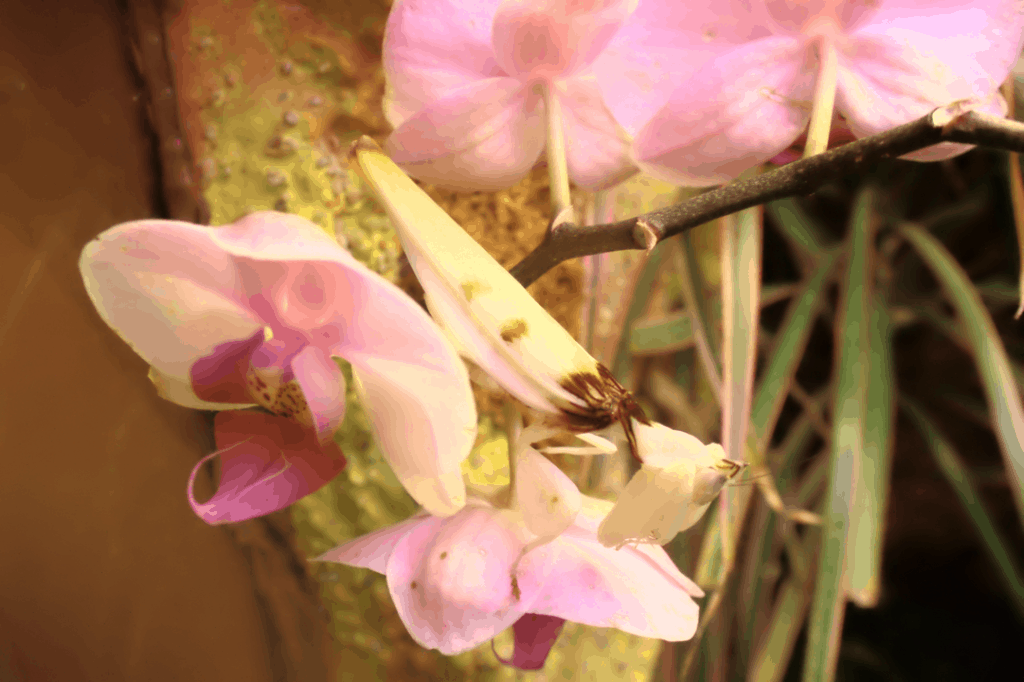
Average Lifespan: 1 Year in captivity, much less in the wild
Interesting Quirk: Despite not living on orchids, it looks a lot like one with its bright pink-ish coloration.
Details: The Orchid Mantis often sports a beautiful pink-ish and white coloration that resembles an orchid flower–especially in females which have lobes on their legs that resemble flower petals.
This serves as an amazing camouflage that can be of great assistance in avoiding getting eaten by larger predators. Found in the wild within Malaysia the Orchid Mantis also makes a popular pet thanks to its gorgeous coloration. Females tend to be absolutely massive compared to males–females often grow to 6cm or 7cm and males are a comparatively tiny 2.5cm. Sexual cannibalism is again a factor with the Orchid Mantis, occurring the usual 25% of the time when mating occurs. The average lifespan in captivity is about a year for the Orchid Mantis. As with other Mantis species, a good deal of humidity is needed to ensure they are comfortable in their terrarium/aquarium.
Think this bug is cute? Check out our article with photos and facts about all the cutest bugs in the world: The Cutest Bugs in the World
The Chinese Mantis
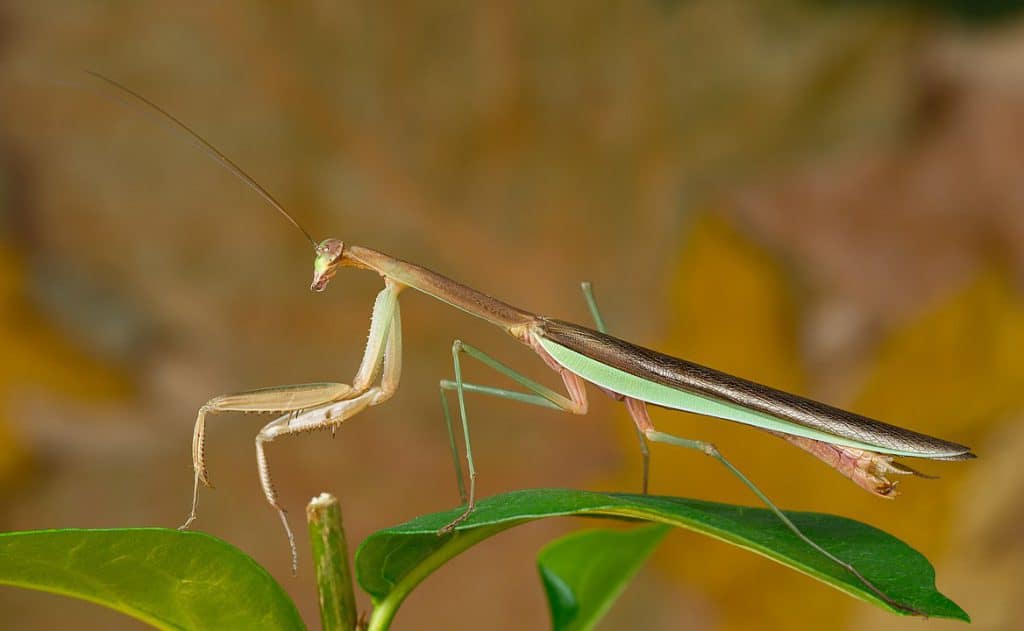
Average Lifespan: 1 year in captivity, much less in the wild.
Interesting Quirk: Originally only found in Asian countries, international commerce resulted in its spreading to North America as well.
Details: The Chinese Mantis is often brown or dark green. It looks like a regular Mantis with no extra special features like the kind of lobes found on Orchid Mantises or such.
The average size of a full-grown Chinese Mantis is about 9cm and while females do get a bit bigger and heavier than males, it is not nearly as noticeable as with some species of Mantises. Sexual cannibalism is as always a risk if the female is hungry when mating, so keep that in mind if you try to breed Chinese Mantises! The Chinese Mantis makes a solid pet thanks to being relatively low-maintenance, needing just some humidity and the usual food-items of small insects such a flies.
The European Mantis

Average Lifespan: 1 year in captivity, much less in the wild.
Interesting Quirk: Originally found exclusively in Europe, these were imported to North America in the 1600s.
Details: The European Mantis in some ways looks like the “Archetype,” of all other Mantis species. It has the telltale shape and body-size of Mantises but lacks any big features that make others unique. One notable aspect of the European Mantis is that it can be very aggressive when it spots prey, chasing it down relentlessly.
Females tend to be about 7cm big and males are just a bit smaller at 6cm. Sexual cannibalism is a consistent concern with the European Mantis and when kept as pets they just need the standard considerations of humidity, live insects to munch on, and the like. It almost sounds derogatory to say the European Mantis lacks much of note, but by being relatively plain it helps illustrate how much variety can exist in the species of Mantises!
The South African Mantis
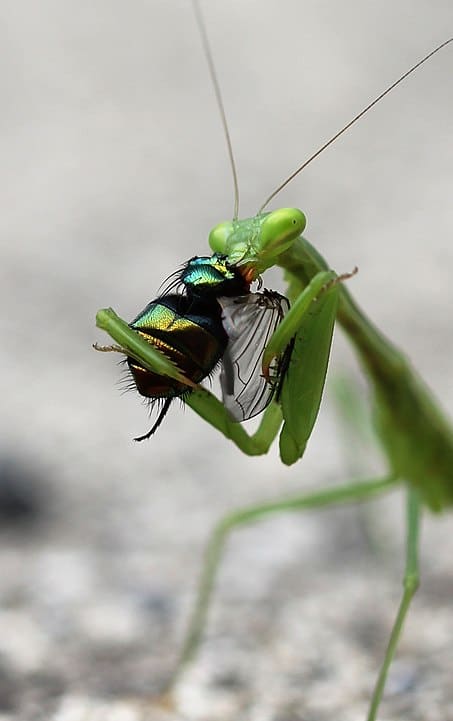
Average Lifespan: 1 year in captivity, much less in the wild.
Interesting Quirk: Sometimes the brown varieties have beautiful purple eyes.
Details: The South African Mantis is also sometimes known simply as the African Mantis or Common Green Mantis (despite some being brown) and is most often found around the region of Sub-Saharan Africa in the wild (and Worldwide when in captivity). They can be green, beige, and sometimes brown. Females tend to be about 8cm and males 6cm-7cm, keeping the trend of females being larger and (you guessed it!) engaging in sexual cannibalism at times. True to their native habitat, this species of Mantis likes the temperature quite hot in the wild as well as within a terrarium/aquarium.
The Devil’s Flower Mantis
Average Lifespan: 1 year in captivity, much less in the wild.
Interesting Quirk: Has a fearsome appearance that has made it famous!
Details: The Devil’s Flower Mantis is found in the wild within Tanzania (in Africa) and is quite expensive to acquire as a pet. This is because of its scary appearance that looks like dead leaves when the Mantis is still and if it chooses to expose its assortment of imposing bright colors it can be quite devlish!
Besides their amazing colors they can be huge, with females up to 10cm in length and males about the same size but more slender and with bigger, “Feathered,” antenna. Despite looking so scary it is actually quite skittish, making breeding quite tricky in captivity (besides there already being the risk of sexual cannibalism). Out of all the Mantis species around the Devil’s Flower Mantis is arguably the most impressive in appearance!
Think this Mantis is cute or creepy?? Either way we’ve got an article with bugs to compare it to! Take a look at The 5 Creepiest Bugs for some really crazy ones!
The Mediterranean Mantis
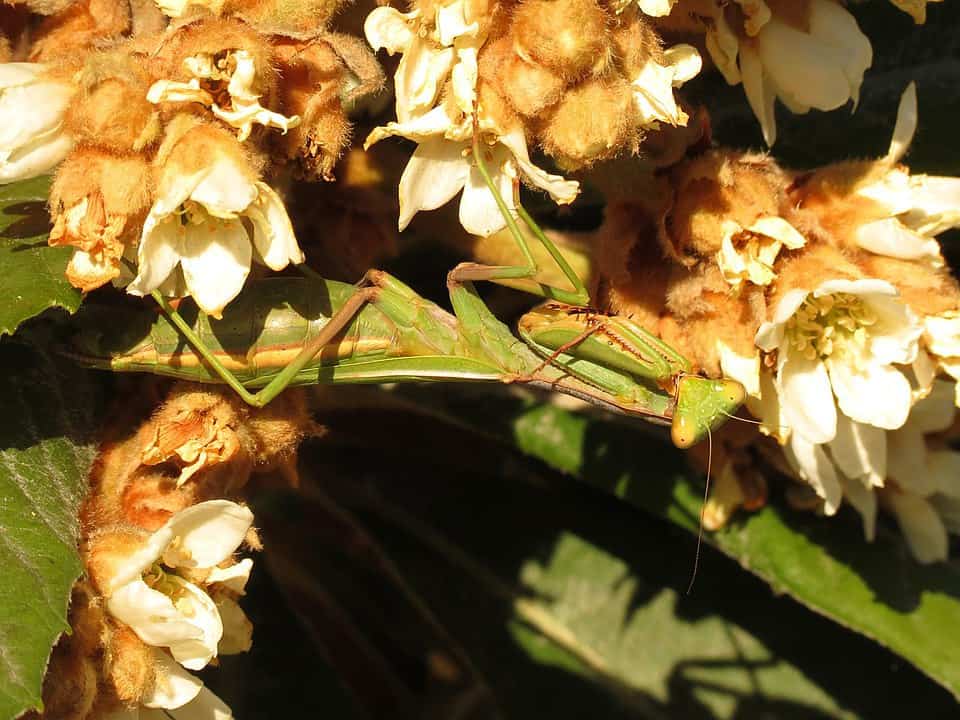
Average Lifespan: 1 year in captivity, much less in the wild.
Interesting Quirk: Often has violet dots on its wings that look like the eyes of a much larger animal and will use these to scare-away threats.
Details: The Mediterranean Mantis is found in multiple parts of the World, thought to originate in Europe before being introduced to other continents. When first born it often looks quite pale but as it ages turns a darker green. Generally, it grows to 6.5cm with females being a bit larger than males. As with all Mantis species, there is a chance of sexual cannibalism (1-in-4). The Mediterranean Mantis will often eat small insects and can survive well in various temperatures and humidity levels, which is arguably why it has flourished around the World.
Closing Observations
With over 2,300 different species an article trying to break-down them all would be hundreds of pages long! For that reason, the most Mantises that are the most representative of the species and/or most interesting were examined instead of having a mega-list that would be a chore to read through.
These Mantises that were covered all are pretty notable in some manner and now you know a lot about their lifespans, sizes, and coloration. Sexual cannibalism decreasing the lifespan of males aside, Mantises tend to live for a year in captivity, and much less in the wild. Regardless of if the only live some months or a whole year, however, they are fascinating insects for sure, as this article made clear!
If you enjoyed reading this article, why not check out our articles on Do All Cockroaches Fly? Let’s Find Out and What Color are Praying Mantis’? Blue, Green, etc.
Recent Posts
Tiny Black Bugs in Bathroom NO WINGS: What They Are and What to Do!
Finding tiny black bugs in your bathroom can be uncomfortable, to say the least. Especially if they are persistent, or they appear in very large numbers, which they often like to do. When it...
Tiny Black Bugs in Plant Soil - What Are They & What To Do About It
A short horror story: You get a new houseplant. You do your best to take care of it. You’ve ensured that it has the right soil, the right amount of sun, it gets enough water. And then one day, you...

